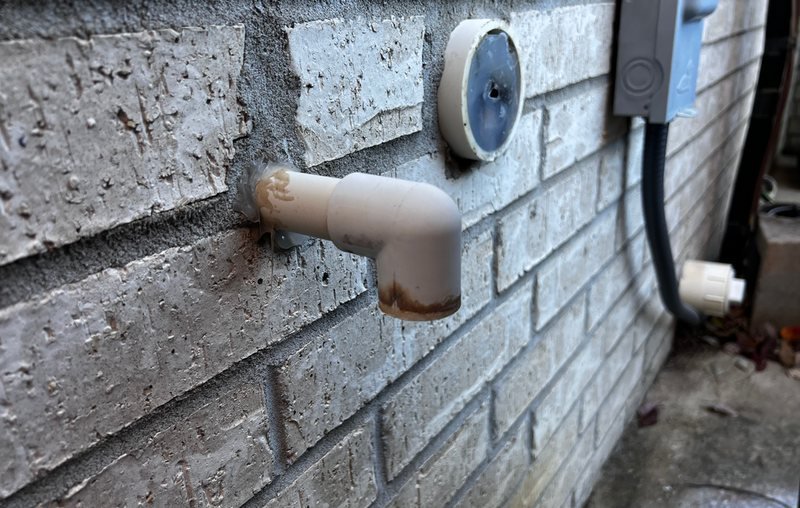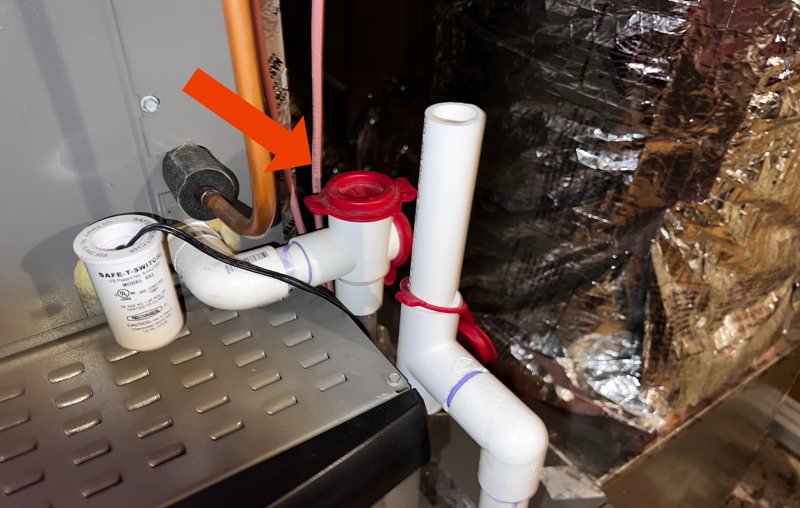How to clear a clogged AC drain line in ten minutes
A clogged AC drain line can create a mess, quick.
Schedule a $29 service call 👉
If your AC’s drain line is clogged, there’s a good chance you have water damage to your ceiling or your home is hot because your AC is shut off. So, let's cut to the chase and get your drain line unclogged ASAP.
NOTE: Unclogging a clogged AC drain line is not difficult, but please don’t do it unless you feel comfortable working around your AC system. It is a serious piece of machinery and you can get hurt if you aren’t careful.
Materials & tools needed:
- Wet/dry shop vacuum (do NOT try to use a normal home vacuum or you will destroy it)
- Duct tape
- Rag or paper towel
- Bleach or vinegar (not required, but recommended)
1. Turn your HVAC system off at the breaker panel. You will likely have two switches that control power to your system - one labeled AC and the other furnace. Turn them both off.
2. Locate your AC drain line. It’s almost always a small PVC pipe behind or near your outdoor AC unit (technically it’s called a condenser). Here’s an example:

3. Attach your shop vac. First, take a rag or towel and wipe off the outside of the PVC pipe. Then, put your shop vac on it and duct tape the gap to create a good seal. If you’re in a pinch, you can also use your hand to create a decent seal.
4. Turn on the shop vac. You should hear water and debris being sucked through the pipe and into your shop vac. If all went well, your drain line should now be unclogged.
5. Test your drain for clogs. Now, go to your indoor HVAC unit (usually in your attic, otherwise in a closet or a crawlspace) and find the start of the drain line. Hopefully, you have a clean out like in the below picture, which can be used for easy access to your drain line. If you do, take the cap off and pour a bit of warm water in to see if it drains (even better, you can pour in a 50/50 bleach or vinegar/warm water mixture to kill any bacteria). If your drain line is unclogged, water will come out of the pipe outside. If you don’t have a clean out, you will have to cut your drain line with PVC cutters and then reattach everything when you’re done with a PVC union and some PVC glue. By the way, while you’re here, go ahead and shop vac any water out of the drain pan below your system.

6. Turn your AC back on. Go back to the breaker panel and turn your AC on. If the drain line is clear and all of the water has been removed from the drain pan, your AC should start working again. You can confirm by going outside after the AC has been running for a few minutes. If you see water dripping out of the PVC, you were successful and your drain line is at least partially clear. Nice job!
If you did all of the above and your drain line is still not unclogged, you may need help from an HVAC contractor with special tools. Don’t worry though, it’s usually not too expensive to clear a drain.
What causes a clogged AC condensate drain line?
Your air conditioner produces water when it cools the air inside your home. That water has to go somewhere, so HVAC technicians pipe it outside your home via a small PVC line. Over time, that line fills with debris and even bacteria if not regularly cleaned. If enough time goes by, it can become so dirty that water is no longer able to travel through it, causing all types of AC issues.
Why does a clogged drain line turn your AC off?
Most modern air conditioners have something called a float switch installed which shuts off power to your system if it detects too much water. It does this to protect your home from water damage. Other than an AC that’s not turning on, a common symptom is a blank thermostat or error saying there’s no power to the Rh wire.
How to clean an AC drain line with vinegar or bleach
A 50/50 mixture of vinegar or bleach with warm water will kill any bacteria growing in your drain line. To clean out your drain with the above mixture, go to your indoor unit and look for the drain line (3/4” PVC coming out of your system). Hopefully, you have a clean out which you can simply remove and then slowly pour your mixture into (a picture of which is located towards the top of this post). Doing this once or twice a year should help keep your air conditioner drain from clogging.
A slightly easier alternative to the above is regularly putting cleaning tablets in your drain pan.
What is an AC drain line?
An AC drain line (also called a condensate drain line) carries the water produced by your air conditioner outside so that it doesn’t cause water damage to your home. It is typically made out of 3/4” PVC, starts at your indoor HVAC unit, and comes out near your outdoor unit.
Signs of a clogged AC drain line
- Water damage to ceiling
- AC not working
- Water in drain pan
- Blank thermostat or error saying there’s no power to the Rh wire






